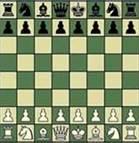
OPENINGS: Fried Fox (B00)
Fried Fox (B00) [1. e4 f6 2. d4 Kf7]
By all appearances, this irregular opening breaks the rules of opening theory; by move #2, Black is behind in center control and development of pieces, and the King has been moved (preventing castling) to a position where it can be checked on Move 3 with 3. Bf4 ...
Marcus Fox used this opening to beat Jacques Miesus in 1885. I was unable to find that game and I was unable to find any other time that this opening has been used in master games.
IN this forum [ http://www.chess.com/opening/eco/B00_Fried_fox_Defense ] one member had this to say:
The Fried Fox was first mentioned by Polerio in 1590, but didn't come to prominence until the Viennese player Marcus Fox used it to beat Jacques Mieses in 1885. A year later, the Berlin player Horatio Fried wrote a piece analyzing it for the German chess magazine Die Bruderschaft. Siegbert Tarrasch in his masterwork The Game of Chess commented that the Fried Fox "cannot be considered theoretically correct since (1…f6) does nothing to further black's development. In actual practice, however, as recent experience has shown, it can be quite effective since it sets the first player the enormously difficult problem of maintaining and increasing his slight advantage from the opening, and in attempting to solve the problem, it is very easy to go astray." It wasn't until the rise of the Hypermoderns, Nimzowitsch, Reti and Gruenfeld, that the Fried Fox really began to catch on at the master level. Most recently, Magnus Carlsen has apparently been using it in offhand blitz games, and reports that "black's position is surprisingly resilient." Can the day when we see it make its debut in a world championship match be far off?
Another member said:
This openning plays off of the psychological aspect of chess. Within a two hour game each GM master has only one hour of in game thought. Aside from this time they also have an almost endless amount of time to study opennings, tactits, and anything else that comes to mind. He didn't make this opening because it was stronger. I made it because he knew that his apponent could not prepare for this opening. It may not be perfect, but it alows him to fully function in a way unexpected toward his apponent, and this is why playing a computer does not procure the full aspect of chess.
The statement in regards to the "psychological aspects of chess" seems to make sense, as it has seen use in Blitz and Bullet Chess where time is very limited and White is suddenly faced with a predicument which s/he would not have prepared for. This suggests that the Fried Fox is of little tactical value but more towards psychological value.
I was showing a friend from work, Roy, this opening earlier today. Roy sat down at the side of Black and started moving pieces. I shrugged and sat down at the side of white and the game continued. We were unable to finish the game; but,when we parted from the table, this was our position:
I play chess almost daily here on Chess.com; Roy has not played in many years, yet was able to apparently defend against attack, claim his share of center and equalize the playing field.
His success indicates that the Fried Fox may be of more tactical value then given its due credit.
The remaining comments and articals I could locate simply scoffed the idea, calling it "perposterous" and "ludicrous" (among other colorful adjectives) and strongly cautioned others to not use this opening, reminding us that this opening breaks all rules of opening theory.
We are currently experimenting with this opening in Vote Chess. Feel free to join in. At present, only the game where Starfleet Academy plays black exists; our opponents hastily cancelled the match where they were set to play Black. A challenge has been sent to "Chess Champ", the team against whom we are playing Black, in hopes that they accept this challenge as they are currently White against us.
Chess is an art. A wise woman (my mother) once said: "There are rules to art, but the first rule is that any rule can be broken, as long as it is broken with elegance".
Let's take a closer look at this bizzarre opening. Please comment; and if you do, let's avoid simple scoffing and please, show me why this is a bad opening! It is often said that we learn more from our losses (i.e. bad moves) than we do from our wins (i.e. good moves). So, if this opening is 2 bad moves from the start, please explain.
In response to this request for analysis, a member said:
It's bad for any number of reasons... man, I wish someone would play this against me out the gate... sweet!
Anyway, I hope this isn't classified as scoffing, but the scoffers are right. Besides the fact that your diagram .... it also shows a lack of planning on White's part. The Black King is exposed... I would think that White's "mainline" would be to castle Queenside and pawnstorm on the Kingside. ... Black is still inferior here - look at the development. Every threat is being generated by White. Black's pieces are passive and defensive. His Kingside has holes everywhere, especially the tasty one on g6. While I appreciate unusual openings, this one does not seem to do the trick.
1) Takes away the f6 square from the knight, usually its best square in the opening.
2) Creates Kingside weaknesses and holes that prove tough to solve.
3) Makes it harder to develop the h8 rook, since castling is now off-limits.
4) Makes it difficult to develop the f8 bishop if the g8 knight develops to e7.
Among other things...
When White performs this maneuver, it is called the Hammerschlag (A00) and is often confused with the Fried Fox:
